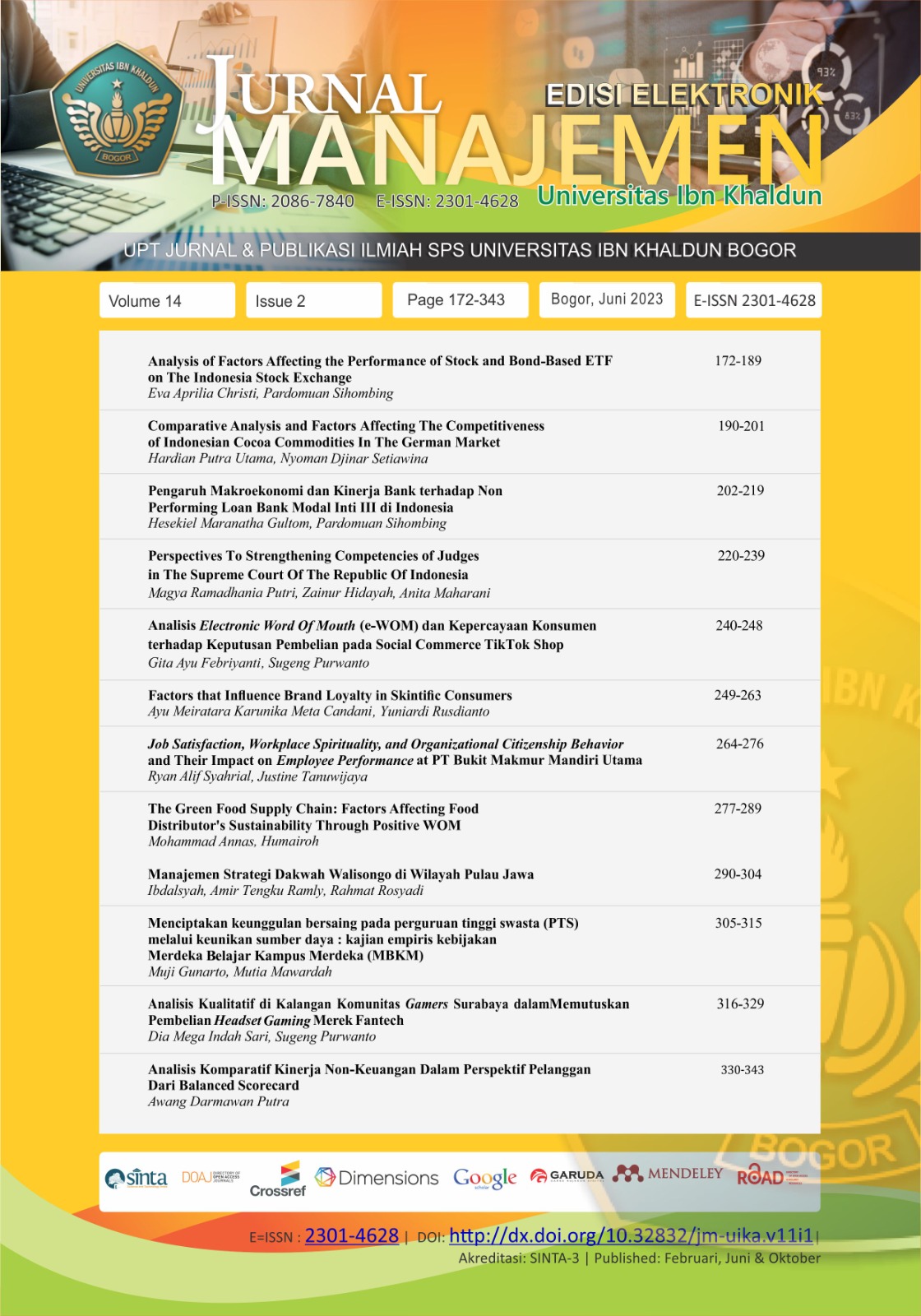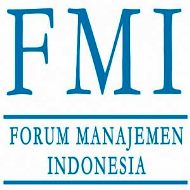Perspectives to Strengthening Competencies of Judges in The Supreme Court of The Republic of Indonesia
DOI:
https://doi.org/10.32832/jm-uika.v14i2.11228Keywords:
Competency-based development, Stakeholder Theory, Competency-Based Human Resource ManagementAbstract
Judges as court apparatus, play a pivotal role in improving organizational performance and enhancing public trust. They are the sole actor who determines the quality of court decisions. However, the cases in the four courts, namely general, religious, state administrative and military courts seemed to outnumber the judges; hence retaining highly skilled judges to rule and write decisions within the time frame is paramount. Using a stakeholder theory approach, this article explores the competency-based development model for judges carried out by the technical training centre of the Indonesian Supreme Court. The research method was descriptive qualitative, purposive sampling for in-depth interviews. The result revealed that each stakeholder, namely technical training managers, supporting lecturers or trainers, working unit, and the public, showed different perspectives on judges' competencies, knowledge, skills, and attitude due to different interests. Stakeholders' views highlighted several points: analytical thinking skill improvement, knowledge application, character building, adaptive skills development and reassignment. This study, therefore, provides a new model of judges' competencies development that emphasizes a throughout human resources management activity application, starting from carrying out apparatus management strategy as a response to bureaucracy reform, strategic environmental changes, and science and information technology development; applying human resources development strategy with stakeholder participation approach through training and development centre; and creating apparatus reassignment strategy. These three strategies lead to an agile civil apparatus to achieve good governance.
References
REFERENCES
Amarini, I. (2018). Evaluasi Program Peningkatan Kompetensi Hakim Melalui Pelatihan yang Terintegrasi dan Berkelanjutan di Indonesia. Jurnal Hukum Ius Quia lustum, 25(1), 180-197. DOI: https://doi.org/10.20885/iustum.vol25.iss1.art9
Annual Report 2020-2021 of National Judicial College of Australia. 2021. Canberra: Council of National Judicial College of Australia.
Basten, D and Haamann, T. (2018). Approaches for Organizational Learning: A Literature Review. Journal SAGE Open, 1-20. DOI: 10.1177/2158244018794224
Filho, L.V.P., Carvalho, A.C.L., dan Olson, G. (2020). Institutional Actors in Globalized Society: The Role of Judicial Schools, ENAMAT, and its Training Axes. Journal of the International Organization for Judicial Training, (7), 69-75
Freeman, R.E., Harrison, I.S., Wicks, A.C., Parmar, B.L., De Colle, S. (2010). Stakeholder Theory: The State of The Art. Cambridge: Cambridge University Press
Friedman, A.L. dan Miles, S. (2006). Stakeholders Theory and Practice. Oxford: Oxford University Press
Ganie, S.A. and Saleem, I. (2018). The Transpiring Journey of Competence Based Human Resource Management: A Literature Review. International Journal of Management Studies, 3(7), 17-23. DOI: 10.18843/ijms/v5i3(7)/03
Gomes, A.O., Guimaraes, T.A., and Akutsu, L. (2017). Court Caseload Management: The Role of Judges and Administrative Assistant. RAC Journal, 21(5), 649-665. DOI: https://doi.org/10.1590/1982-7849rac201716017
Hardani, Auliya, N.H., Andriani, H., Fardani, R.A., Ustiawati, J., Utami, E.F., Sukmana, D.J., dan Istiqhomah, R.R. (2020). Metode Penelitian Kualitatif & Kuantitatif. Yogyakarta:Pustaka Ilmu
Indonesia. Peraturan Menteri Pendayagunaan Aparatur Negara dan Reformasi Birokrasi No.6 Tahun 2022 tentang Pengelolaan Kinerja Pegawai Aparatur Sipil Negara, Jakarta.
Kalkavan, G. (2003). Competency-Based Human Resource Management System: Case Studies of a Multinational Company In FMCG Industry and A Native Human Resources Company in Service Industry. Master Thesis. MBA Program T.C. Sile: ISIK University.
Khan, R.A.G., Khan, F.A., and Khan, M.A. (2011). Impact of Training and Development on Organizational Performance. Global Journal of Management and Business Research, 11(7)
Krishna, V. (2019). Developing A Competency-Based Credentialing Framework for National Human Resource Development. International Journal of HRD Practice, Policy and Research, 4(1), 41-58. DOI: 10.22324/ijhrdppr.4.102
Kossowska, M., & SoÅ‚tysiÅ„ska, I. (2002). Szkolenia pracowników a rozwój organizacji. Kraków: Oficyna Ekonomiczna
Lucia, A. D. and Lepsinger, R. (1999). The Art and Science of Competency Models: Pinpointing Critical Success Factors in Organizations. San Francisco: JosseyBass / Pfeiffer
Maharani, D. (2019). Competency Based Learning Implementation for Public Administration Student Program to Improve Competency in Facing Industrial Era 4.0. Journal IAPA, 700-708
May, D.R., Gilson, R.L, and Harter, L.M. (2004). The psychological conditions of meaningfulness, safety and availability and the engagement of the human spirit at work. Journal of Occupational and Organizational Psychology, 77 Psychology Modul
McGuiness, S. and Ortiz, L. (2015). Skill Gaps in the Workplace: Measurement, Determinants, and Impacts. Discussion Paper No.9278. Bonn. Forschungsinstitut zur Zukunft der Arbeit Institute for the Study of Labor, 1-35
Misra, Y and Sharma, V. (2017). An Exploratory Study on Business Strategy, Competency and Firm Performance. SUMEDHA Journal of Management, 6(2), 22-34
Mousa, E.A., Zumrah, A.R., and Nashrief, M. (2017). The Effect of Transfer of Training of the Relationship between Perceive Organizational Support and Employee's Engagement in Sudan's Public Sector Employees. Journal of Education and Social Science, 7(1), 176-182
Munir, M. A. (2013). Issues and Challenges in Training Needs Assessment (TNA) Judicial Education in A Rule of Law Perspective. Proceeding of International Judicial Conference 2013. Lahore. Law of Justice Commission of Pakistan, 1-19
Naicker, T. (2013). The Effect of Knowledge Sharing on Employee Engagement. Minor Dissertation. Master of Management. Johannesburg: University of Johannesburg.
Nasriyah, R. Arham, Z. and Aini, Q. (2016). Case Report Profile Matching and Competency Based Human Resources Management Approaches for Employee Placement Decision Support System (Case Study). Asian Journal of Applied Science, 9(2), 75-86. DOI: 10.3923/ajaps.2016.75.86
Parmar, B.L. dan Freeman, R.E. (2010). Stakeholder Theory: The State of the Art. Cambridge: Cambridge Management Faculty Publications
Polo, F and Kantola. (2019). Valorazing the Human Capitals within Organization: A Competency Based Approach. Advances in Human Factors, Business Management and Society Journal, (783). DOI: https://doi.org/10.1007/978-3-319-94709-9_6
Prabawati, I., Meirinawati, and Oktariyanda. (2018). Competency-based Training Model for Human Resource Management and Development in Public Sector, Journal of Physics: Conference Series, 1-6. DOI: 10.1088/1742-6596/953/1/012157
Rachman, T. (2014). Penerapan Competency Based Human Resources Management (CBHRM) dalam Rangka Pengembangan Modal Insani (Human Capital) Karyawan di PT Traktor Nusantara Jakarta. Jurnal IPB. 1
Reaves, R. (2016). Continuing Education for Judges. Journal of the International Organization for Judicial Training, (5), 11-18
Sienkiewicz, L. (2014). Competency-Based Human Resources Management. Warszawa: Instytut Badan Edukacyjnch
Schoonover, S.C. (2002). Implementing Competencies: A Best Practice Approach. Falmouth: Schoonover Associates
Suny, K.G. and Yajurvedi, N. (2022). Enhancing the Efficacy of Organizational Competitive Advantage Through Employee Empowerment. Journal of Positive School Pyschology, 6(3), 5457-5465
Supreme Court of the Republic of Indonesia. (2021). Executive Summary of 2021. Jakarta: Mahkamah Agung RI
Sze, T.Y. (2013). Building A Learning Community of Judicial Practice- The Experience of Subordinate Courts of Singapore. Journal of the International Organization for Judicial Training, 1(1), 23-30
The 2022 Executive Summary of Lithuanian Court, study on strengthening the competency of court managers for effective management of judicial resources
Thomas, Cheryl. (2006). Review of Judicial Training and Education in Other Jurisdiction. Report Prepared by the Judicial Studies Board. London Project Office, London. University of Birmingham School of Law. 1-136
UNDP and Department of Personnel Training of India. (2014). Indian Civil Services Competency-Based Human Resources Management. New Delhi: Government of India
Wiyono, G. (2017). Strategi Penerapan Organizational Learning untuk Membentuk Guru Pembelajar di Sekolah. Jurnal Edukasi Elektro, 1(1), 69-77
Downloads
Published
How to Cite
Issue
Section
License
Copyright (c) 2023 Jurnal Manajemen (Edisi Elektronik)

This work is licensed under a Creative Commons Attribution-NonCommercial 4.0 International License.
Authors who publish with this journal agree to the following terms:
- Authors retain copyright and grant the journal right of first publication with the work simultaneously licensed under a Creative Commons Attribution-NonCommercial-ShareAlike 4.0 International License that allows others to share the work with an acknowledgement of the work's authorship and initial publication in this journal.
- Authors can enter into separate, additional contractual arrangements for the non-exclusive distribution of the journal's published version of the work (e.g., post it to an institutional repository or publish it in a book), with an acknowledgement of its initial publication in this journal.
- Authors are permitted and encouraged to post their work online (e.g., in institutional repositories or on their website) prior to and during the submission process, as it can lead to productive exchanges, as well as earlier and greater citation of published work (See The Effect of Open Access).











